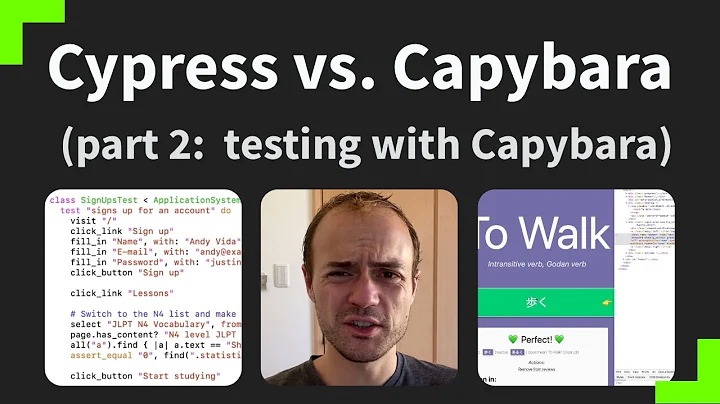How to make Capybara check for visibility after some JS has run?
Solution 1
I think that the find statement here is the one with the implicit wait, so Capybara will wait until the element is on the page, but won't wait for it to become visible.
Here, you would want Capybara to wait for the visible element to appear, which should be achievable by specifying the visible option:
expect(page).to have_selector('#blah', visible: true)
I haven't tried it, but the ignore_hidden_elements configuration option might be useful here as well, if you wanted find to always wait for visible elements.
Solution 2
This is another way to do it that works perfectly fine for me:
find(:css, "#some_element").should be_visible
Especially for more complex finds, such as
find(:css, "#comment_stream_list li[data-id='#{@id3}']").should_not be_visible
which would assert that an element has been hidden.
Solution 3
If you want to check that an element is on the page but is not visible, visible: false won't work as you might expect. Had me stumped for a bit.
Here's how to do it:
# assert element is present, regardless of visibility
page.should have_css('#some_element', :visible => false)
# assert visible element is not present
page.should have_no_css('#some_element', :visible => true)
Solution 4
Using:
Ruby: ruby 1.9.3dev (2011-09-23 revision 33323) [i686-linux]
Rails: 3.2.9
Capybara: 2.0.3
I have a Rails application in which there is a link which when clicked should submit an AJAX post request and return a JS response.
Link code:
link_to("Send Notification", notification_path(user_id: user_id), remote: true, method: :post)
The JS response (.js.haml file) should toggle the following hidden div on the page the link exists:
#notification_status(style='display:none')
js.haml file contents:
:plain
var notificationStatusContainer = $('#notification_status');
notificationStatusContainer.val("#{@notification_status_msg}");
notificationStatusContainer.show();
I was testing my scenario of sending notification and displaying the notification status message to the user using Cucumber (cucumber-rails gem with built in Capybara support)
I was trying to test that the element having id: notification_status was visible on successful response in my step definition.For this I tried following statements:
page.find('#notification_status').should be_visible
page.should have_selector('#notification_status', visible: true)
page.should have_css('#notification_status', visible: true)
page.find('#notification_status', visible: true)
page.find(:css, 'div#notification_status', visible: true)
Neither of above worked for me and failed my step.Out of the above listed 5 snippets the last 4 failed with following error:
'expected to find css "#notification_status" but there were no matches. Also found "", which matched the selector but not all filters. (Capybara::ExpectationNotMet)'
which was strange because following statement was passing correctly:
page.has_selector?('#notification_status')
And in fact I inspected the page source using
print page.html
which showed up
<div style='' id='notification_status'></div>
which was expected.
Finally I found this link capybara assert attributes of an element which showed up how to inspect an element's attribute in raw manner.
Also I found in Capybara documentation for visible? method (http://rubydoc.info/github/jnicklas/capybara/master/Capybara/Node/Element#visible%3F-instance_method) following information:
Not all drivers support CSS, so the result may be inaccurate.
Thus I came to the conclusion that when testing visibility of an element do not rely on results of Capybara's visible? method when using a CSS selector and using the solution suggested in link capybara assert attributes of an element
I came up with following:
module CustomMatchers
def should_be_visible(css_selector)
find(css_selector)['style'].should_not include('display:none', 'display: none')
end
end
World(CustomMatchers)
Usage:
should_be_visible('#notification_status')
Solution 5
What visible means is not obvious
The failure may come from a misunderstanding of what is considered visible or not as it is non-obvious, not driver portable, and under-documented. Some tests:
HTML:
<div id="visible-empty" ></div>
<div id="visible-empty-background" style="width:10px; height:10px; background:black;"></div>
<div id="visible-empty-background-same" style="width:10px; height:10px; background:white;"></div>
<div id="visible-visibility-hidden" style="visibility:hidden;" >a</div>
<div id="visible-display-none" style="display:none;" >a</div>
The only thing Rack test considers as invisible is inline display: none (not internal CSS since it does not do selectors):
!all('#visible-empty', visible: true).empty? or raise
!all('#visible-empty-background', visible: true).empty? or raise
!all('#visible-empty-background-same', visible: true).empty? or raise
!all('#visible-visibiility-hidden', visible: true).empty? or raise
all('#visible-display-none', visible: true).empty? or raise
Poltergeist has a similar behavior, but it can deal with internal CSS and Js style.display manipulation:
Capybara.current_driver = :poltergeist
!all('#visible-empty', visible: true).empty? or raise
!all('#visible-empty-background', visible: true).empty? or raise
!all('#visible-empty-background-same', visible: true).empty? or raise
!all('#visible-visibiility-hidden', visible: true).empty? or raise
all('#visible-display-none', visible: true).empty? or raise
Selenium behaves quite differently: if considers an empty element invisible and visibility-hidden as well as display: none:
Capybara.current_driver = :selenium
all('#visible-empty', visible: true).empty? or raise
!all('#visible-empty-background', visible: true).empty? or raise
!all('#visible-empty-background-same', visible: true).empty? or raise
all('#visible-visibiility-hidden', visible: true).empty? or raise
all('#visible-display-none', visible: true).empty? or raise
Another common catch is the default value of visible:
- it used to be
false(sees both visible and invisible elements), - currently is
true - is controlled by the
Capybara.ignore_hidden_elementsoption.
Full runnable test on my GitHub.
Related videos on Youtube
Kevin Davis
Product Manager at Microsoft, working on Yammer. Dabbling in my own projects, usually with Rails.
Updated on December 27, 2020Comments
-
Kevin Davis over 3 years
After loading a page I have code that runs and hides and shows various items based on data returned by an xhr.
My integration test looks something like this:
it "should not show the blah" do page.find('#blah').visible?.should be_true endWhen I manually go to the page in the context this test runs, #blah is not visible as I expect. I suspect that Capybara is looking at the initial state of the page (invisible in this case), evaluating the state of the DOM and failing the test before the JS runs.
Yes, I set the
:js => trueon the containing describe block :)Any ideas would be greatly appreciated! I'm hoping I don't have to put an intentional delay in here, that feels flaky and will slow things down.
-
 Ciro Santilli OurBigBook.com over 9 yearsWhat is the driver? What is the expected HTML once the XHR finished?
Ciro Santilli OurBigBook.com over 9 yearsWhat is the driver? What is the expected HTML once the XHR finished?
-
-
Phương Nguyễn over 11 yearsThe
should_not be_visibledoesn't look good to me as Capybara runwait_until { base.visible? }when Element#visible? being invoked. -
Marc-André Lafortune about 11 yearsYou can't use
should_notwith capybara, because of ajax -
Zubin about 11 years@Marc-AndréLafortune, to test ajax with capybara use Capybara.javascript_driver.
-
Marc-André Lafortune about 11 yearswith javascript_drive,
have_csswill wait for your whole timeout duration before giving up, because it expects to find the element. E.g. you have to useshould have_no_contentinstead ofshould_not have_content. -
Zubin about 11 years@Marc-AndréLafortune, that's interesting - didn't realise that. Handy to know!
-
solidcell about 11 years@phng-nguyn, #wait_until has been removed from recent versions of Capybara.
-
installero about 11 yearsThis is actually a better variant than the "page.should have_selector ...", because in case if a failing text, it's would say that the element is actually invisible explicitly, whereas the mentioned variant just evokes 'there were no matches' error, that is a little bit frustrating.
-
parhamr over 10 yearsThis solution is not future compatible, as
wait_untilwas removed from Capybara 2. -
Chris Beck about 10 yearsin case anyone initially misses @Kevin's note (like me), you must have
js:trueon the containing block for this to work. -
Ian Vaughan over 9 yearsUse
Timeout.timeout -
Theymiss Developer about 9 yearsGreat answer - thanks for the effort you put into this. Testing visibility of elements in a suite using multiple drivers is non-trivial.
-
Jason Swett about 9 years
expect(page).not_to have_selector("#some_element", visible: true)worked fine for me usingjavascript_driver, without waiting the whole timeout duration. -
Jason Swett about 9 yearsScratch that. I'm having some awful race condition now.
-
Jason Swett about 9 yearsOkay, apparently sometimes you have to wait for the page to load before using
have_selector. I usedfind()with some arbitrary element on the page. I remember having this issue before. My fix feels slightly like a hack, but I don't know of a better solution. -
rizidoro about 9 years"it used to be false (sees both visible and invisible elements), currently is true, and is controlled by the Capybara.ignore_hidden_elements option." See this blog post for more info: elabs.se/blog/60-introducing-capybara-2-1
-
Zubin about 9 yearsUpdated method for second assertion, as @Marc-AndréLafortune correctly pointed out.
-
Marc-André Lafortune about 9 yearsActually, since my comment, this has been changed and you can (and should) use
should_notnow, sorry! -
 Chuck Bergeron almost 9 yearsThis is awesome. It helped me get to:
Chuck Bergeron almost 9 yearsThis is awesome. It helped me get to:expect(page).to have_selector('#flash-message', visible: false, text: "Signed in Successfully")-- thanks for posting this answer -
 trueinViso over 8 yearsThe visible option had no effect for me when testing the visibility of a jquery slide down element. I had to use expect(find('#blah').visible?).to be_falsey.
trueinViso over 8 yearsThe visible option had no effect for me when testing the visibility of a jquery slide down element. I had to use expect(find('#blah').visible?).to be_falsey. -
 johncip about 8 yearsThis is not the same as the accepted solution. For this code, Capybara will only wait until the element is in the DOM, and then check visibility immediately. If you're expecting the visibility to change, this can add a race condition to the specs.
johncip about 8 yearsThis is not the same as the accepted solution. For this code, Capybara will only wait until the element is in the DOM, and then check visibility immediately. If you're expecting the visibility to change, this can add a race condition to the specs. -
Nakilon almost 8 yearsBetter use
Selenium::WebDriver::Wait -
 user1735921 almost 8 yearsI want something like is_visible? then do that else do something else
user1735921 almost 8 yearsI want something like is_visible? then do that else do something else -
Thomas Walpole over 7 yearsIf you specify 'visible: :hidden` that will only match elements on the page that are not visible so you only need one assert/expectation.
-
 Antrikshy about 7 yearsDoes anybody know if
Antrikshy about 7 yearsDoes anybody know if.should_not be_visiblecoversdisplay: noneset by jQuery? It doesn't seem to work for me. -
Nickolay Kondratenko about 7 yearsif you use selenium only









